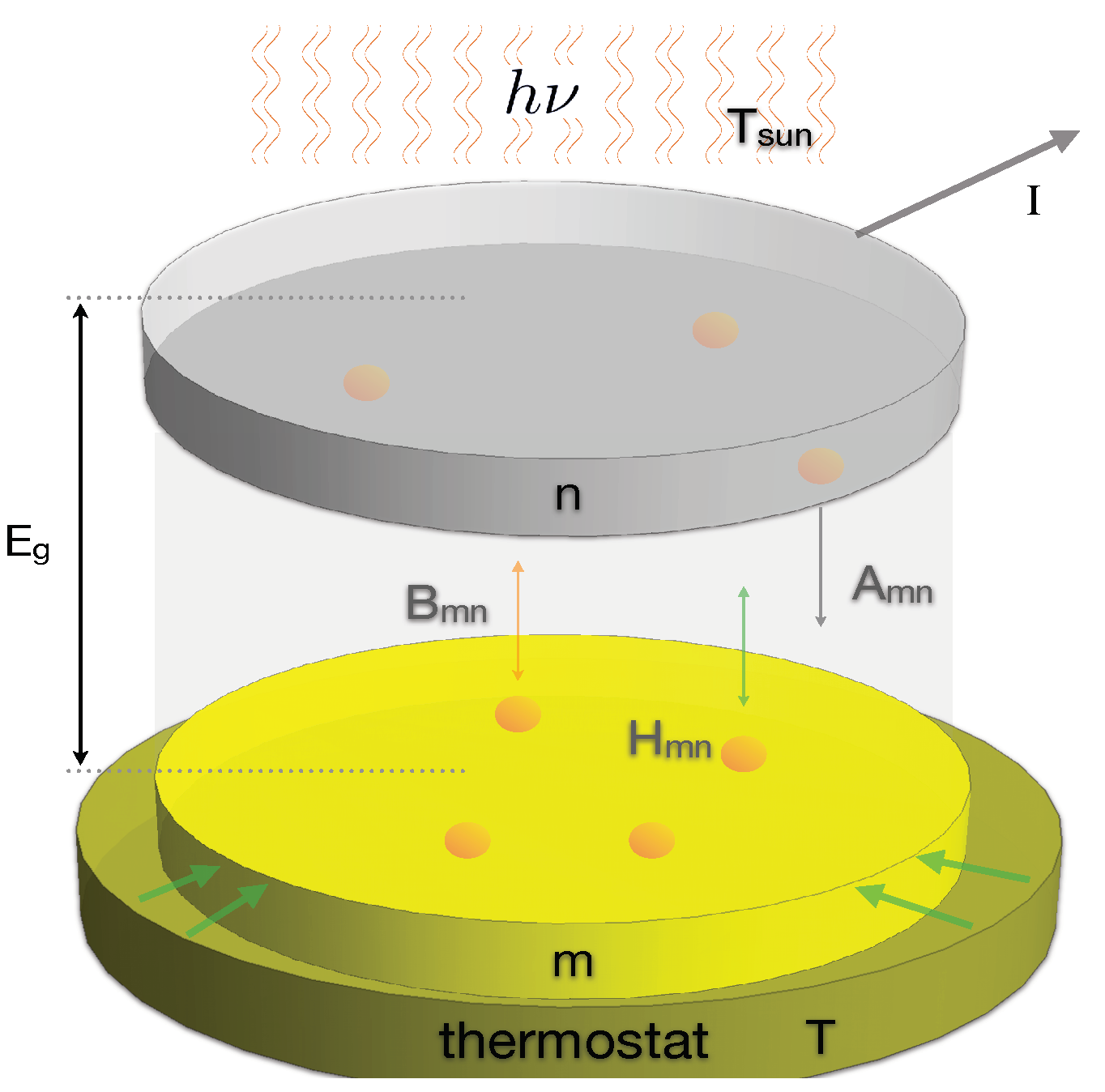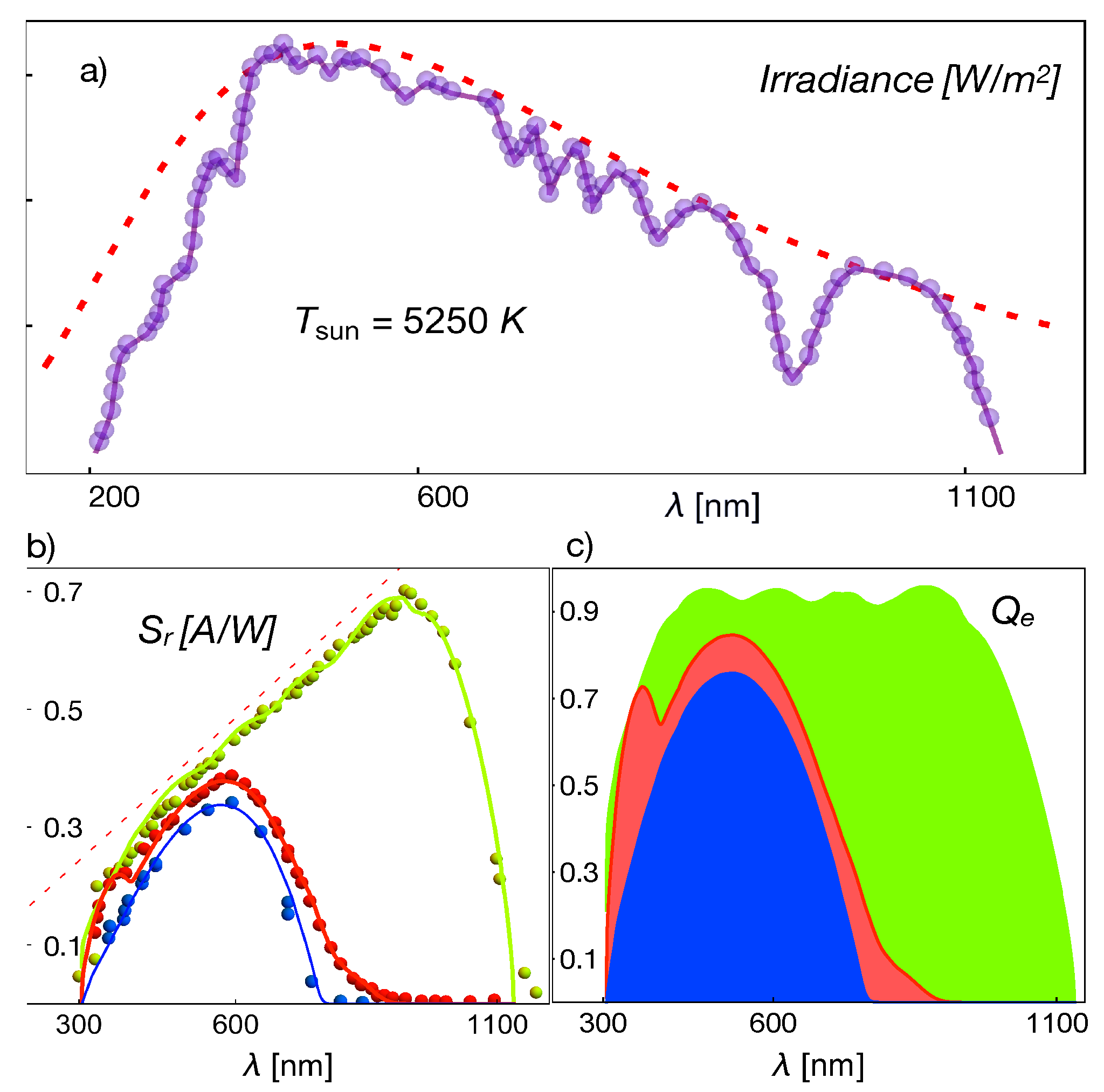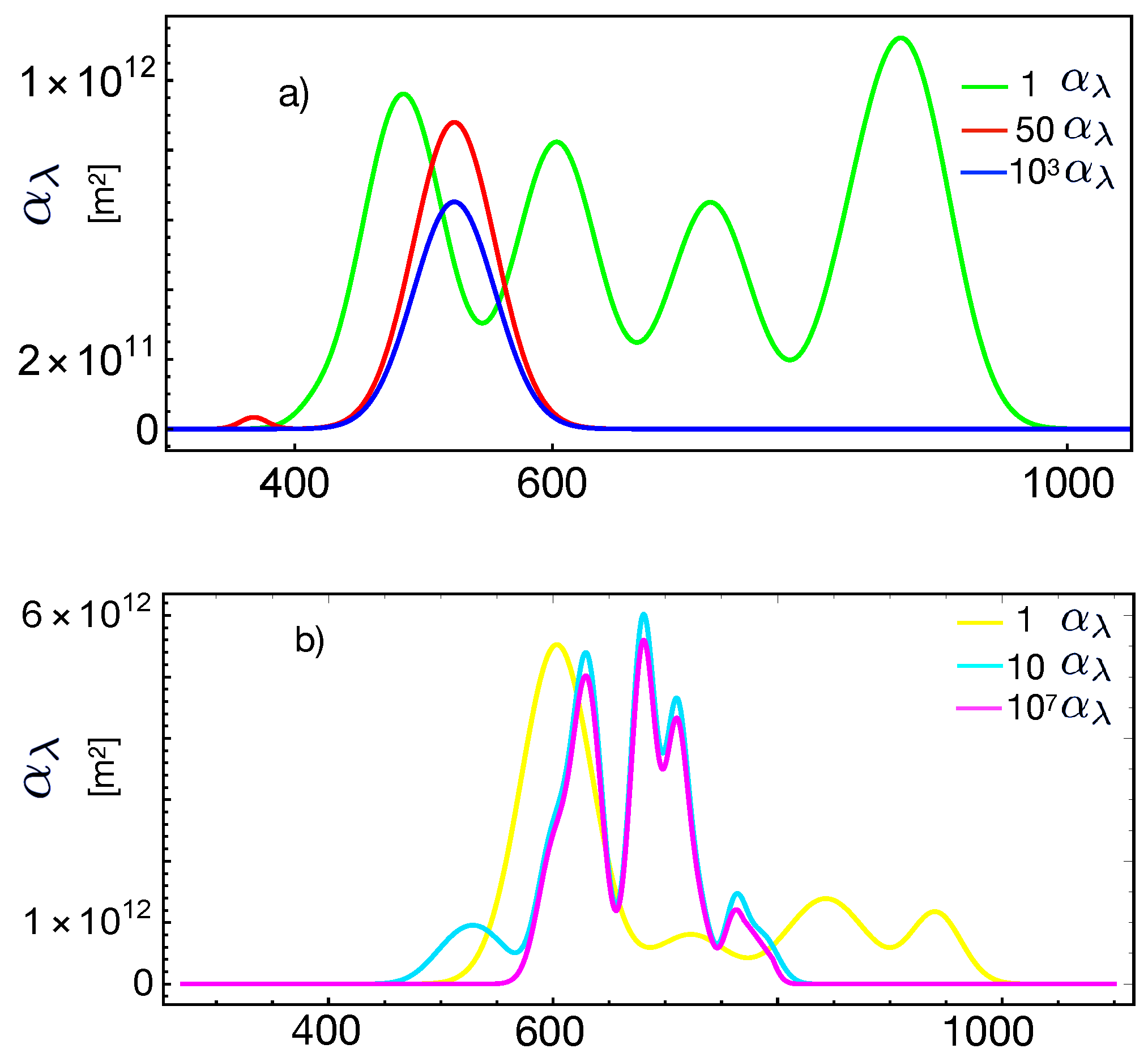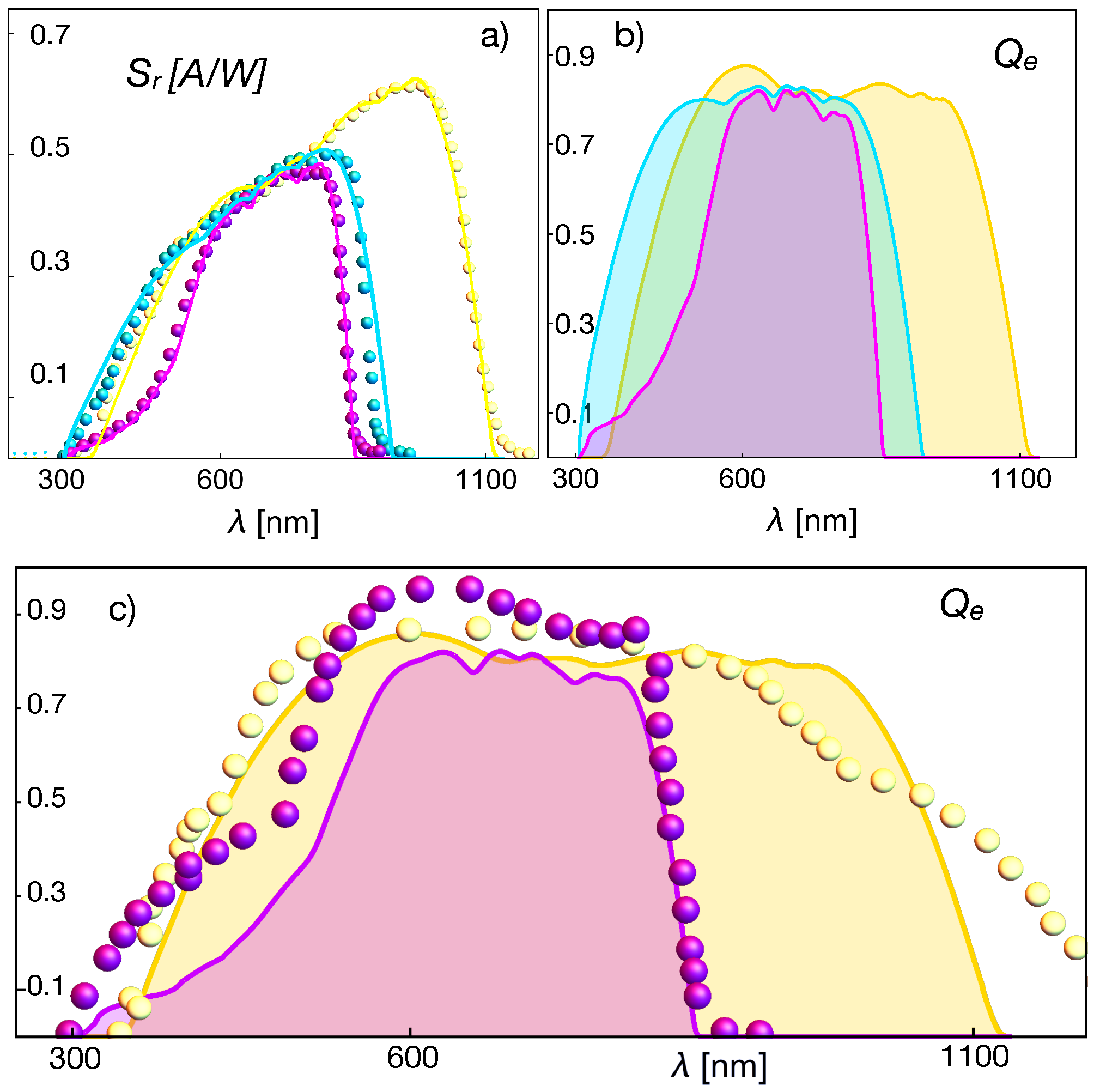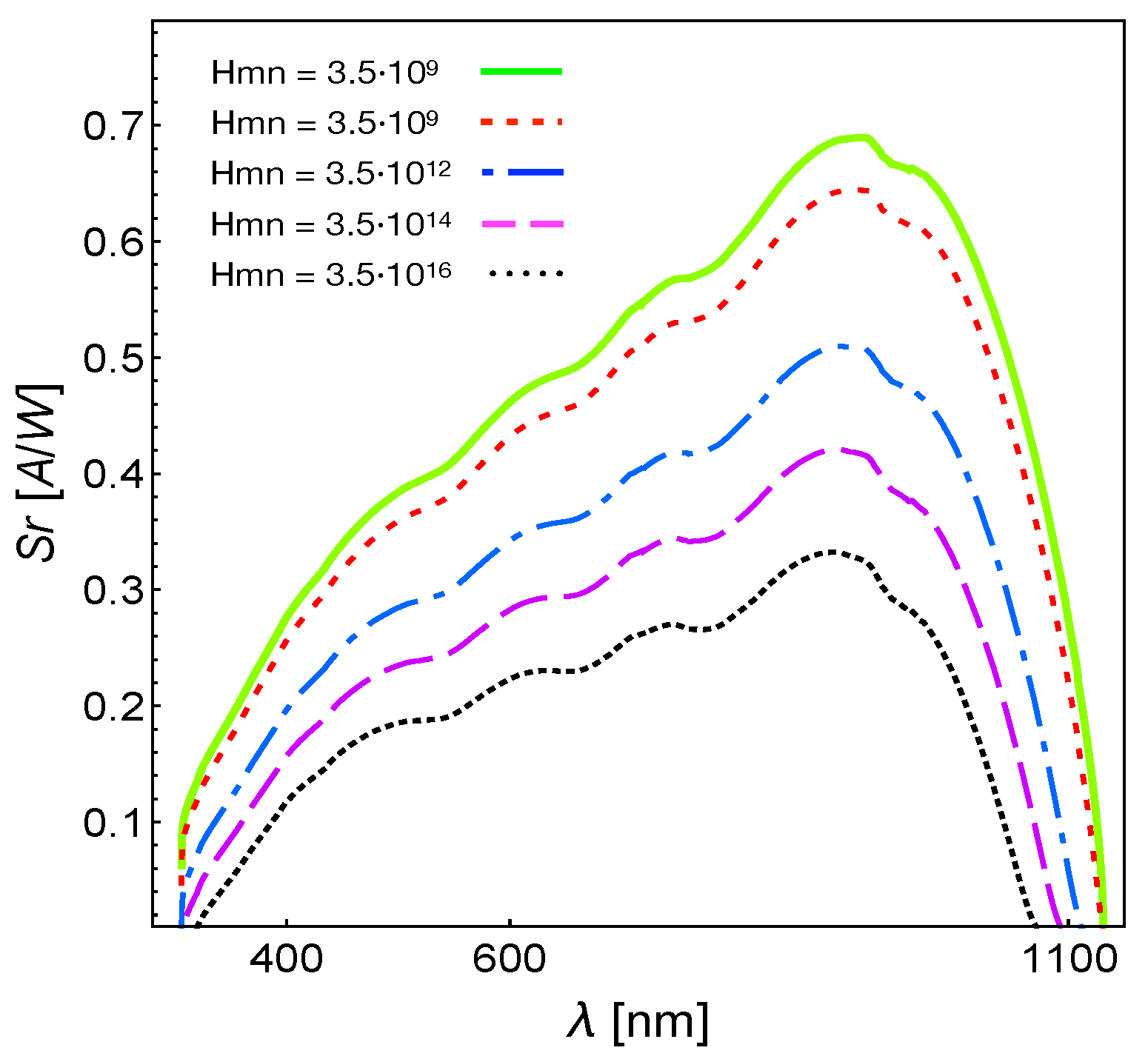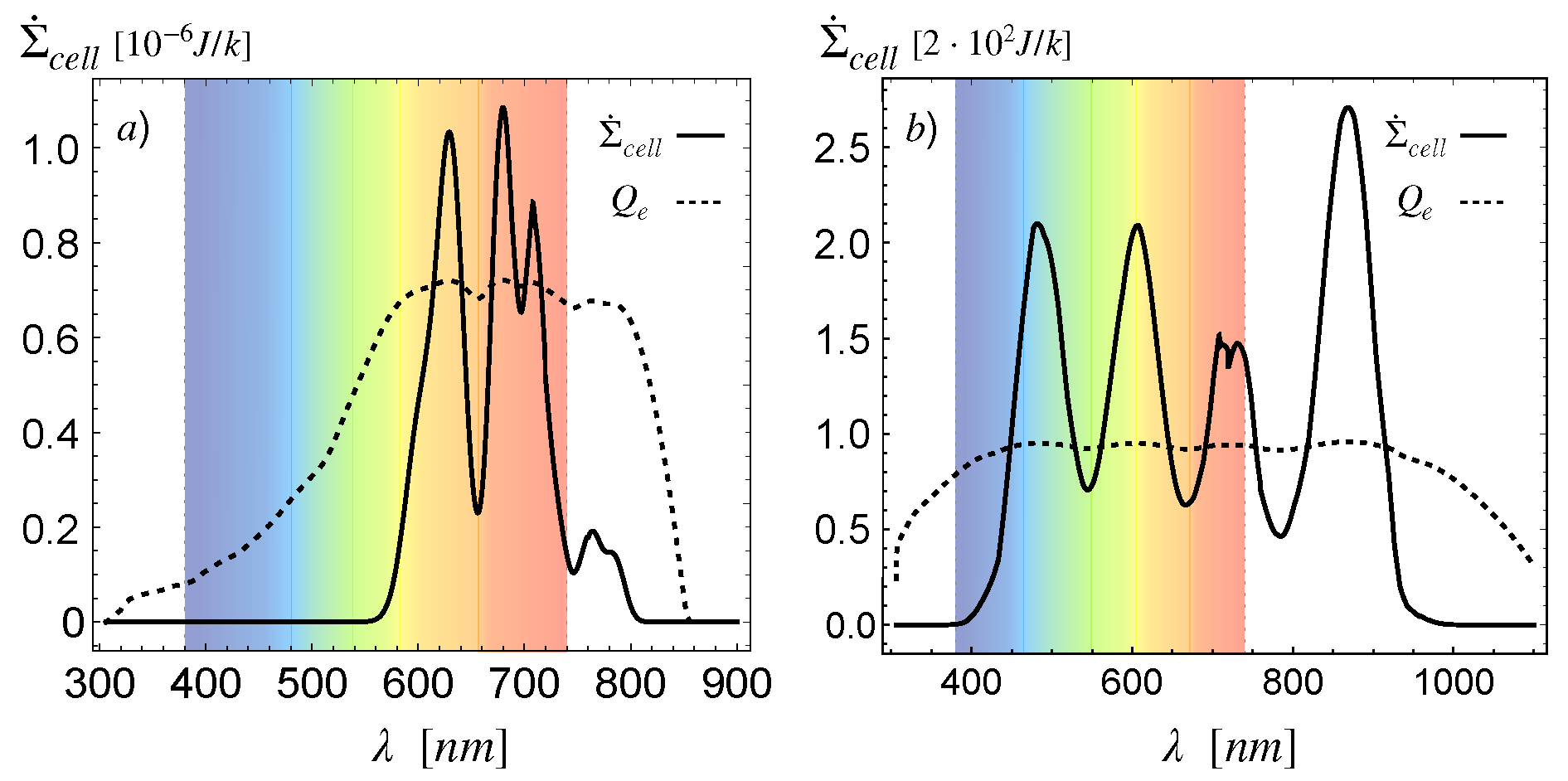1. Introduction
In photovoltaic cells (PVCs), light absorption promotes the transference of electrons from the valence to the conduction bands, thus allowing electrical energy production from light. The efficiency with which this process occurs is crucial for these devices’ practical operation, and therefore, one of the fundamental aspects for theoretical investigations. The estimation of this efficiency follows the classical works by Schockley and Queisser [
1]. This analysis tacitly assumes radiation-matter thermal equilibrium when employing the detailed balance relation. Posterior research improved this approach by considering that solar cells operate at steady-state conditions rather than at equilibrium; this was the case of the classical works by Wurfel [
2] and Tiedje and coauthors [
3].
References [
4,
5,
6,
7,
8] provided classical contributions on this subject. The analysis of the efficiency during non-equilibrium operation starts by introducing the quasi-Fermi energy levels for the electrons and holes, from which the electrical potential generated by the charge separation originates. This electrical potential is the output voltage of the cell, and it is associated with the so-called internal chemical potential
, defined as the difference between the previously mentioned quasi-Fermi energy levels. These relations lead to the current-voltage relationship for the solar cell [
3]. In its more simple form, these improvements are based on the two-level atom approach or can be reduced to it [
9].
Recent theoretical approximations to the assessment of the spectral response and external quantum efficiency are diverse, (see, for instance, [
10]), although the vast majority are based in computational programs solving the electrodynamic and electron and hole transport equations in semiconductor junctions under several assumptions; see, for instance, [
11,
12,
13,
14]. Analytical approaches are also reported in the phenomenological and quantum realms. In the first realm, the important contributions are associated with the introduction of light’s chemical potential, in a similar form as in the present work; see, for instance, the reports by Markvart and coworkers [
15,
16,
17]. In the realm of dissipative quantum systems and quantum thermodynamics approach, the modeling is usually based on two-level atom systems for which generalized (LGKS) quantum master equations are used with the Jaynes–Cummings Hamiltonian with the Lindblad operator for the dissipative terms [
18,
19,
20,
21].
From a more practical perspective, PVCs’ performance is characterized by a series of quantities related to each other. The overall cell performance follows from the net power generated by the solar cell divided by the net input power provided by the incident radiation (the Sun). However, the spectral response,
, and the quantum efficiency
, are the other two spectral quantities that measure the performance of PVC cells, providing precise information of this performance in terms of the frequency or wavelength. These two quantities are not independent. The relation between the quantum efficiency and the spectral response is:
In this work, we undertook the problem of calculating these two quantities from a two-level atom model and showed that they are proportional to the non-equilibrium photochemical potential of the incoming photons [
17,
22]. Our approach’s compelling perspective is to use these results to calculate mathematical relations for the spectral response and the quantum efficiency containing the peculiarities of the transition probabilities entering the equations that describe the population dynamics between states. We also discuss thermodynamic-related quantities like the spectral entropy production and the semiconductor’s efficiency for converting light input into an electrical current output. The merit of this work is that it shows that the key thermodynamic quantity in this whole situation is the photochemical potential. This quantity acts as the thermodynamic driving force, per wavelength band, yielding the entropy production of the cell and reducing its total efficiency.
Our analysis was based on a two-level atom model and did not consider recombination effects in terms of the classical view of electron-hole interaction. Nonetheless, we incorporated recombination processes due to radiative-induced processes and thermal coupling with the thermostat. As we show below, even in this case, the results obtained were auspicious since they allow one to reproduce quantitatively, with a fair degree of precision, experimental reports on the wavelength dependence of the spectral response and the quantum efficiency.
The two-level atom model is the most basic model describing appropriately the dynamics of the formation and recombination of minority carriers in semiconductors due to the incidence of light [
9]. The model allows generalizations, like the inclusion of recombination effects and its extension to multi-state dynamics. Given its simplicity, it can easily be related to the non-equilibrium thermodynamics of photovoltaic cells. A direct correlation can be established between thermodynamic quantities and the quantum parameters entering the quasi-phenomenological Einstein model for the interaction between light and matter. From the quantum perspective, we used this level of approach because of the known difficulties of introducing dissipation due to the interaction with thermal reservoirs in the pure quantum approach [
18,
19,
20,
21].
The model is quasi-phenomenological as the Einstein coefficients
and
possess quantum microscopic bases, having its replica in alternative approaches just as in [
18]. Similarly, the normalized state populations
and
correspond to the diagonal elements of the density matrix. Hence, the Einstein equations are neither more nor less than the diagonalized form of the quantum master equation.
The advantage of using this approach is that the statistical description of the dissipative processes can be directly related to the irreversible thermodynamics concepts and techniques. They differ from the traditional equilibrium approach because in addition to considering the unbalance of the temperatures between the light and the cell, the interaction with a thermostat to which a heat flow is continuously expelled during cell operation is also considered explicitly.
2. Radiative Energy-Exchange Out of Equilibrium: A Phenomenological Model
Let us consider a semiconductor junction that exchanges energy with (i) the incoming radiation from the Sun and with (ii) a thermal bath with which energy is exchanged through heat conduction; see
Figure 1.
The incoming light induces transitions of electrons from the valence to the conduction band, changing the semiconductor atoms’ energy distribution. In this representation, the dynamics of a two-level atom model copes with the essential physics when explicit electron-hole recombination is neglected [
3,
9]. This recombination could enter our model by including non-linear terms, i.e., defining reaction constants that depend on the occupation numbers of both states. However, this does not mean that two-level atom models lack recombination effects since transitions from the higher to the lower energy level are considered through radiative recombination, spontaneous emission, and thermal effects, all of them characterized by different rate constants. The transitions occur between the ground
m and excited
n bands of the semiconductor, having energies
and
that correspond to the quasi-Fermi energy levels of the valence and conduction bands [
3]. We assumed that these transitions match stimulated and spontaneous emission and absorption of photons of frequency
, where
stands for the energy gap.
Mathematically, the model can be assembled with the help of the Einstein-like model [
23,
24] for which the evolution equation for the normalized number of atoms in the ground state,
m, of the semiconductor materials is:
where it is essential to emphasize that, since the electromagnetic energy density producing the transitions has its origin in an external source, for example, the Sun, it approximately follows Planck’s radiation formula:
where
5250–5600 K is the approximate temperature of the Sun and where we included the emissivity coefficient
that accounts for the deviation of the Sun’s emission with respect to the black body emission. Additionally,
and
are the transition probabilities per unit time due to the stimulated radiation process. These probabilities satisfy the detailed balance condition
, where
are the degeneracies of states
. Additionally, the spontaneous transition rate from
n to
m is represented by
. Finally, the coefficients
and
measure the transition rates induced by the atoms’ thermal interaction with the thermostats. This last interaction is one of the main differences between our approach and the classical works reported in [
1,
2,
3,
4,
5,
6,
7,
8,
15,
17] and summarized in [
25]. In these classical approaches, the assessment of the efficiency of the energy conversion is done by assuming a balance between absorbed and emitted radiation. In this approximation, thermal interaction with the heat reservoir is not explicitly considered in the microscopic mechanism as a possible factor promoting transitions. As will be shown below, the thermal contributions introduce corrections in the upward and backward transition rates, as well as the photochemical potential. Within the microscopic description based on a two-level system, the thermal factor was first considered in [
22], where the radiative interaction between two black bodies was analyzed in approximated form.
The temperature difference between the Sun and the semiconductor acts as a drift that takes the semiconductor’s state away from equilibrium. Hence, it is convenient to rewrite Equation (
2) in terms of the difference between electromagnetic energy densities:
. Thus, by adding and subtracting terms in Equation (
2), we may define the net radiative current:
In this equation, the last term can be identified with the excess minority carrier in the semiconductor [
26]. Using (
4), we may write the more compact equations:
Equation (
5) describes a first-order chemical reaction without the detailed balance, where
and
are the corresponding forward and reverse rate constants or probabilities per unit time of passing from ground to excited states and vice versa. These constants are given by:
It is worth mentioning that
represents an “effective” recombination rate that incorporates spontaneous and radiation-induced recombination, as well as thermally activated recombination effects.
According to Equation (
4),
j is proportional to the net radiation received by the semiconductor from the Sun, which promotes the transference of atoms from the ground to their excited state.
2.1. Equilibrium
Thermal equilibrium is reached when the radiative current
j and the time derivatives
vanish. In this state, the equality of temperatures between the material,
, makes that Equation (
5) reduce to:
The ratio of the equilibrium populations satisfies the canonical relation:
From Equations (
6)–(
8), it follows that
where we used the detailed balance relation for the radiation-induced transition coefficients. In the black body ideal limit, the previous Equation (
9) reduces to Planck’s radiation formula [
24]:
when one takes into account the well-known relation
and the detailed balance relation
is satisfied, [
24]. These results yield the following expression for the number of photons of frequency
,
:
2.2. Out of Equilibrium
Since
, then
, and the entire system is out of equilibrium since there is a net flux of the number of atoms that perform transitions from their ground states
m to their excited states
n. In the non-equilibrium stationary case, the time derivatives of the populations vanish, and Equation (
5) reduces to:
where
and
are the populations in the non-equilibrium stationary state. Related to Equation (
12), note that the left-hand side plays the role of a generating current (see Equation (
4)), and the right-hand-side corresponds to the net recombination current in the classical view, in such a way that under steady-state illumination, both currents balance each other [
25,
26]. Using now Equations (
4), (
7), (
8), and (
12), we can obtain an expression for
:
Notice that the involvement of the coefficient
in this last expressions came from Equation (
4). The stationary radiative current
j breaks the canonical balance due to the fact that it induces the passing of atoms from the lower to the upper energetic level, that is it produces a number of electrons in the conduction band. This effect does not modify the thermal equilibrium between the semiconductor and the thermostat.
The work that is necessary for the light to maintain the continuous production of free charge carriers, characterized by a stationary nonequilibrium number of atoms in the higher energy level,
, with degeneracy
, is accounted for through a macro-canonical correction associated with a free energy change per atom. Thus, we introduce the photochemical potential
through the relation:
is the non-equilibrium number of atoms in the lower energy level with degeneracy
, corresponding to electrons in the valence band. Using Equations (
13) and (
14), one may obtain the explicit expression for:
After performing some algebraic operations, the previous expression can be recasted in the more appealing form:
The last two formulas give the photochemical potential in terms of the difference of electromagnetic energy densities,
, between the input radiation and the output emission by the semiconductor. It is therefore clear that this difference of electromagnetic energy at the surface of the semiconductor plays the role of a spectral drift, unbalancing the internal energy distribution of the semiconductor per frequency or wavelength band, owing to the production of an electrical current if the photochemical potential is large enough to overcome the potential barrier at the junction.
Equation (
15) resembles previous relations obtained for the photochemical potential; see [
15,
17,
22,
25] and references therein. However, there are two main differences that should be emphasized. The first one is the way in which the energy input is incorporated through the difference of electromagnetic energy densities,
, and the second and more important distinction is that Equation (
15) incorporates the interaction with the thermal reservoir of the cell, through the quotients
and
, that does not reduce to unity; see Equation (
6).
5. Entropy Production and Global Efficiency
This section evaluates the spectral entropy production of the semiconductor junction associated with the three different processes during its operation: current production, light absorption, and heat production.
The Gibbs entropy postulate [
35] establishes that the entropy of the cell depends on the populations
n and
m in the form:
where
is the equilibrium entropy of the system and
and
evolve in time according to Equation (
2). The time derivative of Equation (
32) gives the total change of the entropy due to the three previously mentioned processes, since the evolution equation of the populations incorporates the corresponding energy (and entropy) exchanges due to the presence of the radiative and thermal transition rates.
Thus, performing the time derivative of Equation (
32), using the fact that
due to number conservation, and Equation (
7), one can write the following expression for the entropy change per unit time:
The first term on the right-hand side of the last equation is the entropy exchange per unit of time (
) between the cell and the surroundings. This is due to the power input associated with the absorbed incoming light, which is proportional to
j. The exchange of heat between the cell and the thermostat enters through the forward and backward rates
and
. Recall that these rates depend on the thermal rates
and
. The second term on the right-hand side is the spectral entropy production per unit time (
) associated with the generation of free electrons due to the absorption of light and the heat exchange with the thermostat. As is well known, in the stationary state, the entropy exchanged with the surroundings compensates the entropy produced (
), in such a way that the total entropy of the cell remains constant,
. This condition implies Equation (
5) and shows the consistency of our analysis.
Therefore, the entropy production per unit time,
, can be written in the form:
Using Equations (
7) and (
14) in order to rearrange the terms in the logarithm, it is possible to find:
which, in view of the definitions (
17) and (
21), is an alternative way to write the Joule heat effect, that is the power dissipated by an electric current. In
Figure 6, we plot both the spectral entropy production given through Equation (
35) and the quantum efficiency (26). The comparison shows that the light input energy is dissipated in generating minority carriers, showing the expected correlation between the quantum efficiency and the spectral entropy production.
Additionally, considering stationarity, the total entropy exchange
satisfies the equation:
This quantity can be divided into two parts, one associated with energy exchange between the cell and the radiation at temperature
:
and the other one with the energy exchange between the cell and the thermostat at temperature
T:
where
, and the inequalities make reference to the fact that the thermal energy flow goes from the radiation field to the thermostat across the junction. Comparing Equations (
37) and (
38) with (
36), one may infer that the stationary energy flow can be identified as:
Using the fact that
, since
, the explicit expression for the energy flow is:
This definition is compatible with Equation (
4).
Using the relations between the induced transition coefficient
and the spontaneous emission
, one may write Equation (
40) in the form:
where
is the average lifetime of the excited states. Additionally, the energy densities due to the Sun are simplified to
, the Bose–Einstein distribution entering the Planck formula, Equation (
11):
which is corrected by
, the emissivity of the Sun consistent with the irradiance shown in
Figure 2. It is worth recalling here that, in the quasi-equilibrium approximation, the definition (
14) can be substituted into Equation (
7) instead of
, thus leading to the Würfel–Planck distribution [
6,
36]:
This last formula is used for calculating the backward emission flow by the semiconductor when the macroscopic radiation balance (
40) is explicitly calculated. Equation (
43) enables us to write the modified population number:
where the condition
should be obeyed. This condition is fulfilled in the whole range of wavelengths for the cells considered in this work and presented through
Figure 2,
Figure 3 and
Figure 4. The representation of the quantum efficiency suggests that the photochemical potential in Equations (
40) and (
44) can be substituted by its maximum values
, which corresponds to the energy difference between the quasi-Fermi levels [
9]. For instance, in the case of
Figure 2, the value of the gap energy is about
J, whereas for the green line, we have
, for the red line
, and finally,
for the blue line. Therefore, Equation (
44) takes the more usual form:
In view of the previous considerations, Equation (
40) can be used for calculating the average efficiency of the cell if we first consider a proper distribution of excitation modes through their distribution of relaxation times for different frequencies or wavelengths,
, consistent with Equation (
29). Introducing the normalized density of frequency modes
, for the solar cell power per unit surface,
, we can write:
It must be emphasized that our approach can be extended to include a hierarchy of recombination processes [
37] by introducing the appropriate distribution of frequency modes. As suggested in [
38], this can be done by assuming
. This definition of the solar cell power divided by the total solar input
gives the global efficiency of the cell:
When
and
, then the expression obtained reduces to the classical one used in the literature for evaluating the solar cell efficiency, except by the correcting factor
, which originates from our treatment of the problem.
6. Conclusions
We attempted to formulate a novel theoretical approach to evaluate photovoltaic solar cells’ performance in this work. This performance was accounted for by the spectral response, the quantum efficiency, and the spectral entropy production at the microscopic level and in terms of the global efficiency parameter in the thermodynamic limit.
Our approach was based on the two-level atom model, which we modified by including the junction’s coupling with a thermostat that regulates its temperature. Considering the non-equilibrium nature of this energy exchange and conversion process, we adopted a stationary operation regime that breaks the detailed balance and substantially affects the results. The quantification of the non-equilibrium light absorption process was done through a stationary radiative current involving the difference between the input and output radiation from the cell and taking into account the crucial fact of the non-zero value of the chemical potential of photons in this non-equilibrated process. The combination of these two quantities and the appropriate definitions of the cell’s operation current and voltages allowed us to obtain an explicit expression for the spectral response of semiconductor junctions and therefore show that the quantum efficiency of the junction is proportional to the already mentioned photochemical potential. These relevant results allowed us to connect the spectral absorption cross-section with the spectral response and the cell’s quantum efficiency since the spontaneous and radiation-induced transition probabilities per unit time of the two-level atom model depend on this photochemical potential. Using the relationships we obtained, even for a rough model of the spectral absorption cross-section, we were able to perform good fits of the reported data of the spectral response and the quantum efficiency of different cells based on crystalline and amorphous Si, as well as for other junction compositions like GaAs and CdTe.
In addition, we showed that the efficiency of the junction’s energy conversion depends crucially on the ratio between the spontaneous to the thermally induced transition rates.
The theoretical approach presented here is parallel to the well-established solid-state description of the processes taking place in the energy conversion in semiconductor junctions. We believe that it is not a banal exercise. On the contrary, we think it contributes to the subject by clarifying how the coupling between light absorption and cell conversion efficiency depends on the photochemical potential. We consider that a possible limitation of our work consists of not having incorporated the multiple electron-hole recombination processes [
37]. However, the model can be generalized in this way, a task that remains for future work.
